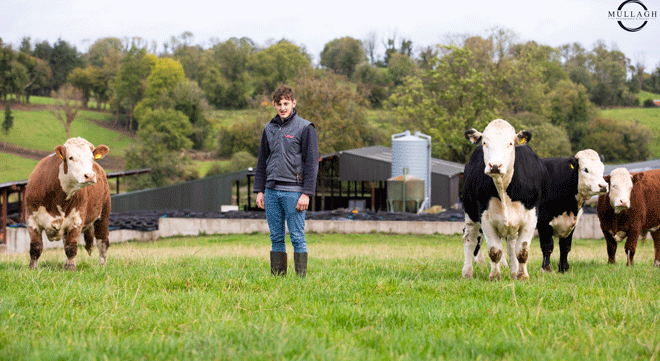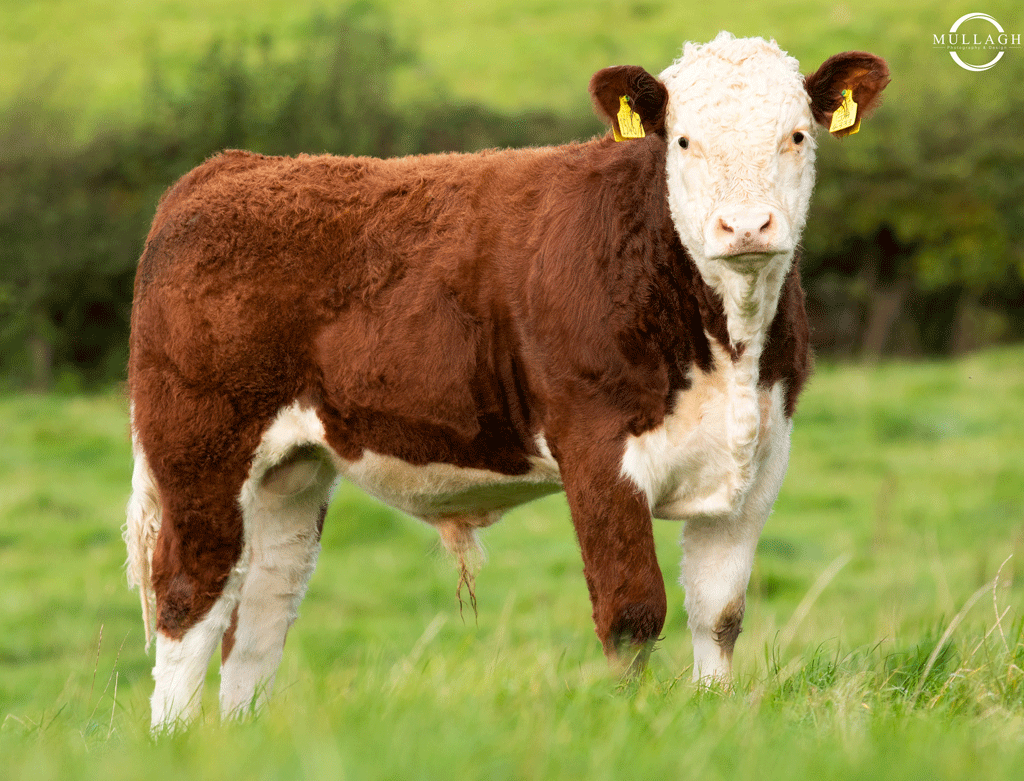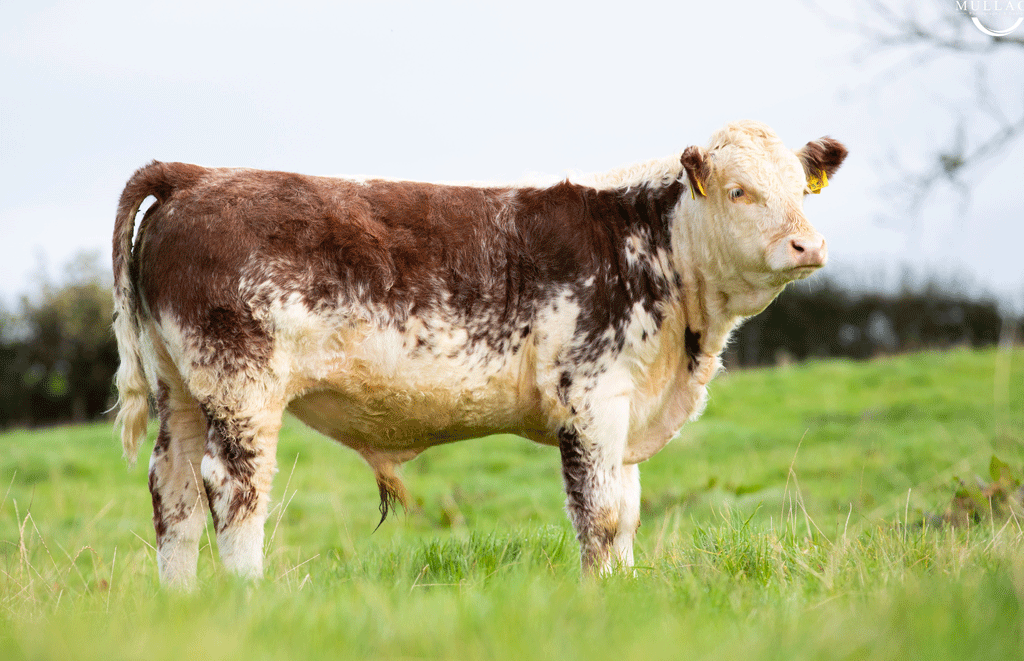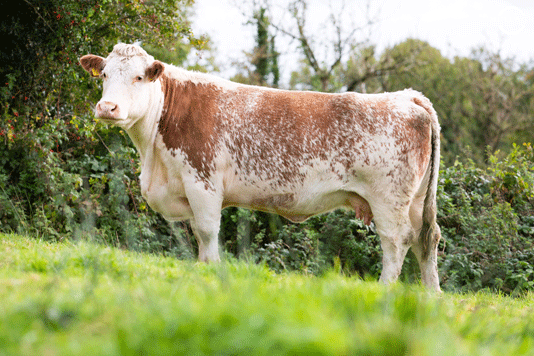
Co Fermanagh’s Robbie Wilson uses a fusion of beef breeds to create his perfect suckler cow, with the Hereford playing a key role.

Hereford cattle numbers in Northern Ireland continue to increase. This trend is reflected in the quantity of Hereford straws sold by the province’s cattle breeding businesses and the number of pedigree breeders now on the ground.
Significantly, AI Hereford usage is in equal demand across both the dairy and suckler sectors. Moreover, breeding companies, including AI Services (Northern Ireland), are keen to source the Hereford genetics they need from local breeders.
Driving the demand for Hereford bloodlines in Northern Ireland is the growing recognition that the breed ticks every box when it comes to producing beef of the highest quality in the most efficient way possible.
Robbie Wilson farms at Magheraveely in South Co Fermanagh at 21 years of age, with the farm extending to 67 hectares (165 acres). His fast developing business comprises a 40-strong herd of suckler cows, a dairy calf to beef enterprise and a 50-strong flock of breeding sheep, with lambs taken through to finishing. He also finishes 100 ‘feeding ewes’ over a 12-month period.
The farm is laid out entirely in grass. Optimal use is made of the available grazing and silage areas. Robbie has succeeded in making four cuts of silage in each of the past two years.
“The plan is to increase the suckler numbers up to 60 cows,” Robbie explains. “The development policy for the herd is centred on a three-way breed combination in equal measure: Limousin, Simmental and Hereford.
“The Limousin delivers excellent conformation, the Simmental has excellent milk production potential while the Hereford guarantees the best possible growth rates from grass and silage.”
He continues: “The beef industry has been told that it must secure higher levels of efficiency in order to lower its overall carbon footprint. The Hereford will play a critical role in making this happen. And increasing numbers of commercial beef finishers are already recognising this fact.”
In his own case Robbie finishes all the male calves born on the farm as steers. He is currently brining many of these animals through to 380kg plus finishing weights at around 27 months of age.
“The heifer calves make perfect suckler replacements,” Robbie comments. “Those which I don’t need for my own use will be sold bulling or as springers. Demand for this type of animal is already very strong. Their uniform, roan colour makes them stand out as an animal with real breeding quality.”

Further evidence of the growing recognition that Hereford-bred cattle are now receiving in Northern Ireland came courtesy of this year’s Fermanagh County Show.
A feature of the day was the success of the newly catalogued ‘non-pedigree suckler cow classic’ and ‘breeding heifer derby’ classes.
Robbie secured a very praise worthy second place in the heifer class with a Saler-cross heifer, bred from a pedigree Hereford cow.
He says: “The heifer was 16 months-old on the day of the show. She is due to calve next February and is a tremendous example of the quality that Hereford genetics can offer the beef sector as a whole.”
For the record, Robbie’s father David of Lisrace Herefords was placed third in the non-pedigree suckler cow class. A pedigree Hereford breeder of note in his own right, he is also committed to working with a mix of Hereford, Simmental and Limousin bloodlines, in order to breed a very sustainable suckler cow.

Robbie is quick to confirm the availability of the Herford price bonus by all the meat plants in Northern Ireland is helping to boost the interest in the cattle at farm levels.
He explains: “The current bonus is allowing finishers with Hereford cattle to secure competitive returns, but the bottom line is that the scope to put more Herefords through the various bonus schemes is significant.”
Meanwhile, the rate of change within Northern Ireland’s pedigree Hereford sector continues apace. Back in 1996, the province was home to 30 active breeders. Today, that figure has grown to approximately 200.
Moreover, the prices paid for pedigree Hereford stock has also increased significantly. The top prices paid for Hereford bulls 30 years ago averaged 1,200gns. Today that figure has risen to some 5,000gns.
Meanwhile, Northern Ireland’s farm minister Edwin Poots has made it very clear he wants to see a ‘genetic revolution’ taking place within the beef sector.
He put breeding the right type of animal at the base of a pyramid that will allow farmers to drive sustainability within their businesses. This means calving suckler heifers down at 24 months of age, ensuring that a suckler animal will calve every 12 months and that finished cattle will be brought to slaughter weights at 24 months of age.
And all of this improvement will be secured on the back of improved grassland management practices. Robbie is in no doubt that Hereford breeding stock will help make all of this happen.
He explains: “Key to the breed is the tremendous selection of bloodlines within it. As a result, there are breeding bulls available that can meet the needs of dairy and suckler farmers in equal measure.
“But the over-riding advantage of the breed is the ability of cattle to finish off grass at an early age plus the superb quality of the beef they produce.”
Robbie’s priority right now is to build a sustainable future for himself from a career in farming.
He says: “Making best use of grass, both from a grazing and silage perspective will be critical in this regard.
“The availability of good housing facilities for stock is also important. And, in this regard, I am well resourced. The farm has an excellent cubicle house for the cows and good quality additional housing for the young stock and finishing animals. The two silos available to me are also in excellent condition.”

Robbie makes four cuts of silage each, mostly as bales, with all grass wilted for 24 hours after cutting.
The commitment to cut grass on such a regular basis is paying dividends in terms of the silage quality available throughout the winter months.
He comments: “We can do most of the work ourselves: a local contractor undertakes the baling and wrapping.”
The quality of Robbie’s bales silage speaks for itself. His cutting dates this year were: 14 May; 06 July; 24 August and 29 September. Last year he consistently produced silage with a D Value of 76; an ME of 12.16 and a DMD value of 21.7.
“The pay-off in cutting grass consistently at that optimal growth stage is the securing of improved growth rates from young stock and a lesser reliance on concentrates when it comes finishing cattle,” says Robbie.
While Robbie is always keen to look forward, sometimes there is a dividend to be gained from looking back in time.
Possibly the best bull ever bred by David Wilson was the exceptional sire: Lisrace Lifeliner. He was the Balmoral 2000 Hereford champion and semen from the bull has been used widely throughout the UK and Ireland over many years.
Robbie says: “We kept 400 straws from the bull for our own use here at home. I am using some of these on my own suckler cows at the present time.
“Lifeliner was a tremendous bull. And his quality is evident, even today. His progeny have tremendous scope and his daughters make excellent suckler cows.”
He concludes: “The Hereford breed has a lot to offer the beef industry in Northern Ireland. And the scope to increase numbers is significant.
“Years ago, Hereford-cross cattle were the backbone of the Irish beef industry. The cattle are unique in achieving very high daily growth rates while also producing beef of an exceptional quality.
“Adding to all of this is the fact that Northern Ireland is home to many excellent pedigree Hereford herds at the present time.”